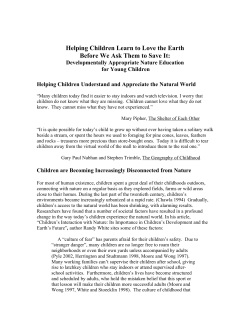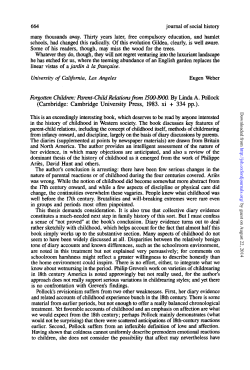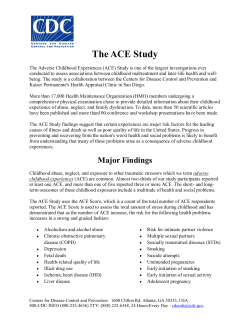
P in Early Childhood: Setting the Stage for Lifelong Healthy Habits
www.excellence-earlychildhood.ca www.skc-ecd.ca APRIL 2011 Physical Activity in Early Childhood: Setting the Stage for Lifelong Healthy Habits P hysical activity is important to many aspects of child health and development. In young children, lack of physical activity is a risk factor for many health problems such as high blood pressure, weight gain, excess body fat, bad cholesterol, respiratory difficulties, cardiovascular diseases and bone health problems. Moreover, the health benefits of physical activity extend well beyond physical health, having a positive impact on the domains of motor skills, psychological well-being, cognitive development, social competence and emotional maturity1-7. Early childhood—that is, 0 to 5 years—is also a critical time for establishing healthy behaviours and patterns that will carry over into later childhood, adolescence and adulthood1-4. Until recently, it was generally assumed that young children were naturally physically active. In the last 10 years or so, it has become evident that many young children do not participate in sufficient physical activity to remain healthy 4. According to the Canadian National Longitudinal Survey of Children and Youth (NLSCY), only 36% of 2 to 3-year-olds and 44% of 4 to 5-year-olds engage in unorganized sport and physical activity each week8. Developmental stages of physical activity Alarming trends in childhood obesity among preschool children have refocused attention on the importance of physical activity in this age group9. In Canada, national data show that 15% of 2 to 5-year-olds are overweight and 6.3% are obese8. In this context, various initiatives are underway to develop guidelines for physical activity in the early years. Physical activity is typically categorized into different intensities2. Light intensity physical activities for young children include dressing up in costumes, standing and painting, and slow walking. Moderateto-vigorous physical activities include running, jumping and playing ball games. These activities happen through structured physical activities, which include any planned programs like gymnastics or swimming lessons, or through unstructured physical activities like playing at a playground, dancing or going to the park. Guidelines for physical activity in the early years focus particularly on facilitated unstructured play and the importance of April 2011 • Parenting Series • Physical Activity The 0-to-5-years age range includes three developmental periods, each characterised by different physical activity patterns1: Infant (0 to 12 months): • First 6 months: Reaches and grasps objects, turns the head toward a stimulus, moves arms and legs. • Second 6 months: Learns of rudimentary movement skills. Toddler (1 to 3 years): • Around 1 year of age: Starts walking, increasing opportunity for exploration and learning. • 2 to 3 years: Develops locomotor skills such as running, jumping and hopping. Emergence of manipulative skills (skills that involve their hands--fine motor skills, like squeezing, grasping, pinching, etc). Preschooler (3-5 years): • Further development of balance, locomotor and manipulative skills. 1 “Infants, toddlers and preschoolers should not be sedentary, restrained or kept inactive for more than an hour at a time, with the exception of sleeping.” Active play: the importance of unstructured physical activity G one are the days when parents would tell their children to go outside, keep themselves busy and not come inside until dark! Today’s parents appear to be shifting their focus away from providing physically active free-play opportunities for their kids, opting instead for organized sport and recreation programs. Yet unstructured physical activity is important for children’s development, and an essential component of getting kids to be more active. Recommendations indicate that at least half of the physical activity accumulated by young children should be in active play. Specifically, children aged 1 to 5 should get from one to several hours of daily, unstructured physical activity8. Throughout the stages of childhood, the type and function of active play changes. Infants typically use play to establish voluntary motor control, while children in the preschool years use play as a form of exercise. Activities such as running and climbing serve not only to develop their muscles, strength, endurance and general movement skills, but are also beneficial for their cognitive and emotional development. Regulation of arousal, development of a sense of mastery, enhanced social cognitions (negotiation, hierarchy and emotional awareness) and gains in spatial cognition are all potential mechanisms through which physical play (exercise and rough and tumble) may influence cognitive outcomes. There is also evidence that active, playground-type breaks can help young children concentrate better at subsequent sedentary tasks10. Supporting active play Families, childcare centres, schools and communities need to provide safe, supervised yet unstructured play spaces for active play, where children and their peers can engage in physical activity of their own design. This will increase physical activity levels and promote imagination, social interaction and the ability to learn and practise skills independently. Exercise play can be enhanced by providing challenging forms of climbing apparatus (always make sure equipment and spaces meet or exceed recommended safety standards). Whenever possible, children should be given access to play spaces and equipment outdoors. Studies have also reported that fewer children per square metre of outdoor space is a factor in promoting physical activity. 2 getting children outdoors8 (see insert on Active Play below). Sedentary behaviours generally involve sitting or lying down, and include television viewing, using a computer, reading and drawing, and motorized transportation. Young children’s natural activity patterns tend to be intermittent, with short intense bursts of activity followed by periods of rest or lower intensity activity2. Although there is a strong consensus that more physical activity is better, there is insufficient evidence of the precise “dose” or amount and intensity of physical activity required for optimal development in early childhood2. Difficulties in accurately measuring the unique physical activity patterns of young children come in part from the fact that young children spend their time in a range of different settings (home, childcare with trained or untrained staff, preschool with varying programs, etc.) and that self-reports are inappropriate at this age4. Despite the sparse amount of research on physical activity in preschoolers, there is enough evidence to suggest that, once they are able to walk, they spend too much of their time sedentary and not enough time in moderate-to-vigorous activity. The table on page 3 provides tips and guidelines relating to physical activity (structured or unstructured) and inactivity in infants, toddlers and preschool-age children. The role of parents and caregivers Young children spend the greater part of their time with their parents or other significant adults, at home and in childcare facilities. Consequently, both parents and caregivers can have a strong influence on the child’s health behaviour. They control the exposure to physical activity opportunities; they act as role models; and parents can use specific parenting practices, such as rules on television viewing1,5. But there’s a lot more to promoting physical activity than limiting screen time. Young children need parents’ and other adults’ support in accessing environments in which to be physically active. Research has shown that young children tend to be more active if their parents participate in physical activity and are active with them, and if they spend more time outside4. This means that parents should model healthy physical activity behaviours by being active themselves, and by interacting with their children in physical activities such as bike riding, walking and active play. Ideally, children need to spend several hours outdoors every day. Finally, because research has shown that boys tend to be more active and less often obese, parents should remember that their girls need to spend just as much time and energy being physically active as boys4. Infants, toddlers and preschoolers should not be sedentary, restrained or April 2011 • Parenting Series • Physical Activity Tips and guidelines relating to physical activity and inactivity in infants, toddlers and preschool-age children* Infants (0 –1 year) Structured physical activity Unstructured physical activity Sedentary and screen time • Encourage physical activity from birth, every day (moving arms, legs, reaching objects, etc.) • Respect natural activity patterns (spontaneous and intermittent) • Avoid TV and electronic media • Provide objects, toys and games that encourage infants to move and do things for themselves Toddlers (1–3 yrs) • Provide 30 minutes of daily (cumulative) structured physical activity • Activities should be fun and occur through physical activity, but also as part of games, transportation and planned activities • Encourage activity that helps child develop competence in movement skills (e.g., throwing, catching or kicking a ball) • Promote gross motor play (e.g., develop head control, sitting, crawling) and fun locomotor activities • Replace screen time with interactive activities that promote brain development: singing, talking, playing and reading together • Provide a safe, nurturing and minimally structured play environment, inside and outside • Avoid prolonged periods restrained in high chair, stroller, etc. • Provide 60 minutes to several hours of daily unstructured physical activity, as part of play, games, transportation and recreation • No more than 60 consecutive minutes of sedentary activity (except sleeping!) • Develop outdoor activity and unstructured exploration under adult supervision (e.g., walking in the park, free play) • With children under 2, avoid spending time viewing TV or electronic media (DVDs, computer and electronic games) • With children between 2 and 3, limit media time to no more than 1–2 hours per day of quality programming • Do not put TV sets in bedrooms • Encourage activities such as reading, athletics, hobbies and creative play • Encourage child to walk instead of using the stroller Preschoolers (3–5 yrs) • Provide 60 minutes of daily (cumulative) structured physical activity • Encourage activity that helps child develop competence in movement skills (e.g., throwing, catching or kicking a ball) • Focus on participation, not competition • Provide 60 minutes to several hours of daily unstructured physical activity, as part of play, games, transportation and recreation • Limit media time to no more than 1–2 hours per day of quality programming • Ensure that free play is fun, safe, and allow for experimentation and exploration • Encourage activities such as reading, athletics, hobbies and creative play • Include a few variables and instruction in unorganized play • Encourage child to walk instead of using the stroller • Do not put TV sets in bedrooms *Selected and adapted from 2010 Active Healthy Kids Canada Report Card on Physical Activity for Children and Youth8, page 7 April 2011 • Parenting Series • Physical Activity 3 kept inactive for more than an hour at a time, with the exception of sleeping. For example, children should be encouraged to walk short distances rather than sit in a stroller, or to alternate walking and sitting for longer journeys. Parents can break up long car trips by stopping at a park or playground for 10 to 15 minutes5. Interventions Relatively few interventions to promote physical activity in children under 5 have been rigorously evaluated. The limited evidence, however, suggests that simple modifications to the outdoor play environment, such as the provision of “offthe-shelf” portable play equipment (like balls or jump ropes), can increase physical activity behaviour. Additionally, training educators to incorporate movement into the standard childcare and kindergarten Several funders financially support the CEECD and the SKC-ECD, including the Social Sciences and Humanities Research Council of Canada, Université Laval, and private foundations. The views expressed herein do not necessarily represent the official policies of these organisations. We are grateful to The Lawson Foundation for its financial contribution to produce this Parenting Series. Centre of Excellence for Early Childhood Development GRIP-Université de Montréal P.O. Box 6128, Succursale Centre-ville Montreal, Quebec H3C 3J7 Telephone: 514.343.6111, extension 2541 Fax: 514.343.6962 E-mail: cedje-ceecd@umontreal.ca Website: www.excellence-earlychildhood.ca Editors: Nathalie Moragues, Richard E. Tremblay, Claire Gascon Giard Writer: Eve Krakow Copy editors: Sandra Braun Valérie Bell Translation: KG traduction Graphic design: Guylaine Couture Photos: Dreamstime stock images, Jennifer Fontaine Printing : SIUM 4 curriculum appears to be effective in increasing physical activity levels during the preschool day7. Preschools, kindergartens and childcare centres should be encouraged to provide children with ample time outdoors on a daily basis, and to provide children with opportunities to be active indoors if the weather prevents them from going outside. Staff should be provided with training in young children’s physical activity, including appropriate activities and strategies. Girls may need sex-appropriate opportunities to be active. Finally, physical environments at centres should include a range of opportunities to support children’s physical activity, including a variety of portable and fixed play equipment and adequate shading. Conclusion With today’s lifestyles, most young kids are not moving enough. Yet the early years are critical, both for children’s physical and psychological growth and for developing lifelong healthy behaviours. More and more countries are developing physical activity guidelines for the 0 to 5-year period. Ensuring that childcare centres and preschools provide children with adequate outdoor play equipment and indoor play spaces can help. But ultimately, parents play the most important role. Not just by limiting screen time, but also by setting the example and providing opportunities for children to be active—whether it’s taking them to the park, the swimming pool or the skating rink, playing ball, or dancing with them in the living room. References: 1-Cardon G, van Cauwenberghe E, de Bourdeaudhuij I. Physical activity in infants and toddlers. Reilly JJ, topic ed. In: Tremblay RE, Boivin M, Peters RDeV, Barr RG, eds. Encyclopedia on Early Childhood Development [online]. Montreal, Quebec: Centre of Excellence for Early Childhood Development; 2011:1-6. Available at: http://www.child-encyclopedia.com/documents/Cardon-van_ Cauwenberghe-de_BourdeaudhuijANGxp1.pdf. Accessed April 15, 2011. 2-Cliff DP, Janssen X. Levels of habitual physical activity in early childhood. Reilly JJ, topic ed. In: Tremblay RE, Boivin M, Peters RDeV, Barr RG, eds. Encyclopedia on Early Childhood Development [online]. Montreal, Quebec: Centre of Excellence for Early Childhood Development; 2011:1-6. Available at: http://www.child-encyclopedia.com/documents/Cliff-JanssenANGxp1.pdf. Accessed April 15, 2011. 3-Jones RA, Okely AD. Physical activity recommendations for early childhood. Reilly JJ, topic ed. In: Tremblay RE, Boivin M, Peters RDeV, Barr RG, eds. Encyclopedia on Early Childhood Development [online]. Montreal, Quebec: Centre of Excellence for Early Childhood Development; 2011:1-9. Available at: http://www.child-encyclopedia.com/documents/Jones-OkelyANGxp1.pdf. Accessed April 15, 2011. 4-Hinkley T, Salmon J. Correlates of physical activity in early childhood. Reilly JJ, topic ed. In: Tremblay RE, Boivin M, Peters RDeV, Barr RG, eds. Encyclopedia on Early Childhood Development [online]. Montreal, Quebec: Centre of Excellence for Early Childhood Development; 2011:1-6. Available at: http://www.child-encyclopedia.com/documents/Hinkley-SalmonANGxp1.pdf. Accessed April 15, 2011. 5-Okely AD, Jones RA. Sedentary behaviour recommendations for early childhood. Reilly JJ, topic ed. In: Tremblay RE, Boivin M, Peters RDeV, Barr RG, eds. Encyclopedia on Early Childhood Development [online]. Montreal, Quebec: Centre of Excellence for Early Childhood Development; 2011:1-5. Available at: http://www.child-encyclopedia.com/documents/Okely-JonesANGxp1.pdf. Accessed April 15, 2011. 6-Reilly JJ. Physical activity in early childhood: Topic commentary. Reilly JJ, topic ed. In: Tremblay RE, Boivin M, Peters RDeV, Barr RG, eds. Encyclopedia on Early Childhood Development [online]. Montreal, Quebec: Centre of Excellence for Early Childhood Development; 2011:1-4. Available at: http://www.child-encyclopedia.com/documents/Okely-JonesANGxp1.pdf. Accessed April 15, 2011. 7-Trost SG. Interventions to promote physical activity in young children. Reilly JJ, topic ed. In: Tremblay RE, Boivin M, Peters RDeV, Barr RG, eds. Encyclopedia on Early Childhood Development [online]. Montreal, Quebec: Centre of Excellence for Early Childhood Development; 2011:1-6. Available at: http://www.child-encyclopedia.com/documents/TrostANGxp1.pdf. Accessed April 15, 2011. 8-Active Healthy Kids Canada. Healthy Habits Start Earlier Than You Think. The Active Healthy Kids Canada Report Card on Physical Activity for Children and Youth. 2010; Toronto, ON. Available at: http://www.activehealthykids.ca. Accessed April 15, 2011. 9-Timmons BW, Naylor P-J, Pfeiffer KA. Physical activity for preschool children — how much and how? Can J Public Health 2007;32:S122–S134. 10-Smith PK, Pellegrini A. Learning through play. In: Tremblay RE, Boivin M, Peters RDeV, Barr RG, eds. Encyclopedia on Early Childhood Development [online]. Montreal, Quebec: Centre of Excellence for Early Childhood Development; 2008:1-6. Available at: http://www.child-encyclopedia.com/documents/Smith-PellegriniANGxp.pdf. Accessed April 15, 2011. The Parenting Series is a publication of the Centre of Excellence for Early Childhood Development (CEECD) and the Strategic Knowledge Cluster on Early Child Development (SKC-ECD). These organizations identify and summarize the best scientific work on early childhood development. They disseminate this knowledge to a variety of audiences in formats and language adapted to their needs. For a more in-depth understanding of physical activity topic, consult our synthesis and Experts’ articles in the Encyclopedia on Early Childhood Development, available free of charge at www.child-encyclopedia.com. April 2011 • Parenting Series • Physical Activity
© Copyright 2025





















